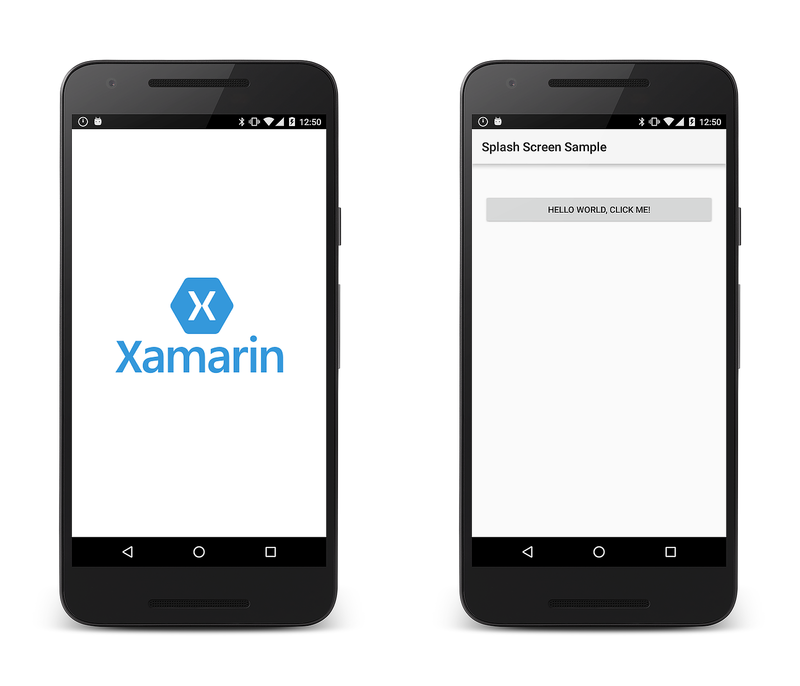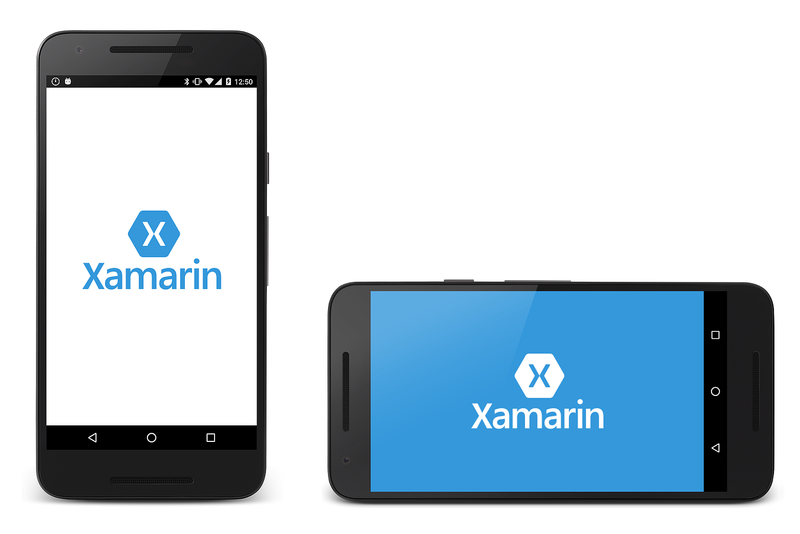Splash Screen
An Android app takes some time to start up, especially when the app is first launched on a device. A splash screen may display start up progress to the user or to indicate branding.
Overview
An Android app takes some time to start up, especially during the first time the app is run on a device (sometimes this is referred to as a cold start). The splash screen may display start up progress to the user, or it may display branding information to identify and promote the application.
This guide discusses one technique to implement a splash screen in an Android application. It covers the following steps:
Creating a drawable resource for the splash screen.
Defining a new theme that will display the drawable resource.
Adding a new Activity to the application that will be used as the splash screen defined by the theme created in the previous step.
Requirements
This guide assumes that the application targets Android API level 21 or higher. The application must also have the Xamarin.Android.Support.v4 and Xamarin.Android.Support.v7.AppCompat NuGet packages added to the project.
Implementing A Splash Screen
The quickest way to render and display the splash screen is to create a custom theme and apply it to an Activity that exhibits the splash screen. When the Activity is rendered, it loads the theme and applies the drawable resource (referenced by the theme) to the background of the activity. This approach avoids the need for creating a layout file.
The splash screen is implemented as an Activity that displays the branded drawable, performs any initializations, and starts up any tasks. Once the app has bootstrapped, the splash screen Activity starts the main Activity and removes itself from the application back stack.
Creating a Drawable for the Splash Screen
The splash screen will display an XML drawable in the background of the splash screen Activity. It is necessary to use a bitmapped image (such as a PNG or JPG) for the image to display.
The sample application defines a drawable called splash_screen.xml. This drawable uses a Layer List to center the splash screen image in the application as shown in the following xml:
<?xml version="1.0" encoding="utf-8"?>
<layer-list xmlns:android="http://schemas.android.com/apk/res/android">
<item>
<color android:color="@color/splash_background"/>
</item>
<item>
<bitmap
android:src="@drawable/splash_logo"
android:tileMode="disabled"
android:gravity="center"/>
</item>
</layer-list>
This layer-list centers the splash image on a background color specified by the @color/splash_background resource. The sample application defines this color in the Resources/values/colors.xml file:
<?xml version="1.0" encoding="utf-8"?>
<resources>
...
<color name="splash_background">#FFFFFF</color>
</resources>
For more information about Drawable objects see the Google documentation on Android Drawable.
Implementing a Theme
To create a custom theme for the splash screen Activity, edit (or add)
the file values/styles.xml and create a new style element for
the splash screen. A sample values/style.xml file is shown below
with a style named MyTheme.Splash:
<resources>
<style name="MyTheme.Base" parent="Theme.AppCompat.Light">
</style>
<style name="MyTheme" parent="MyTheme.Base">
</style>
<style name="MyTheme.Splash" parent ="Theme.AppCompat.Light.NoActionBar">
<item name="android:windowBackground">@drawable/splash_screen</item>
<item name="android:windowNoTitle">true</item>
<item name="android:windowFullscreen">true</item>
<item name="android:windowContentOverlay">@null</item>
<item name="android:windowActionBar">true</item>
</style>
</resources>
MyTheme.Splash is very spartan – it declares the window
background, explicitly removes the title bar from the window, and
declares that it is full-screen. If you want to create a splash screen
that emulates the UI of your app before the activity inflates the first
layout, you can use windowContentOverlay rather than
windowBackground in your style definition. In this case, you must
also modify the splash_screen.xml drawable so that it displays an
emulation of your UI.
Create a Splash Activity
Now we need a new Activity for Android to launch that has our splash image and performs any startup tasks. The following code is an example of a complete splash screen implementation:
[Activity(Theme = "@style/MyTheme.Splash", MainLauncher = true, NoHistory = true)]
public class SplashActivity : AppCompatActivity
{
static readonly string TAG = "X:" + typeof(SplashActivity).Name;
public override void OnCreate(Bundle savedInstanceState, PersistableBundle persistentState)
{
base.OnCreate(savedInstanceState, persistentState);
Log.Debug(TAG, "SplashActivity.OnCreate");
}
// Launches the startup task
protected override void OnResume()
{
base.OnResume();
Task startupWork = new Task(() => { SimulateStartup(); });
startupWork.Start();
}
// Simulates background work that happens behind the splash screen
async void SimulateStartup ()
{
Log.Debug(TAG, "Performing some startup work that takes a bit of time.");
await Task.Delay (8000); // Simulate a bit of startup work.
Log.Debug(TAG, "Startup work is finished - starting MainActivity.");
StartActivity(new Intent(Application.Context, typeof (MainActivity)));
}
}
SplashActivity explicitly uses the theme that was created in the
previous section, overriding the default theme of the application.
There is no need to load a layout in OnCreate as the theme declares a
drawable as the background.
It is important to set the NoHistory=true attribute so that the
Activity is removed from the back stack. To prevent the back button
from canceling the startup process, you can also override
OnBackPressed and have it do nothing:
public override void OnBackPressed() { }
The startup work is performed asynchronously in OnResume. This is
necessary so that the startup work does not slow down or delay the
appearance of the launch screen. When the work has completed,
SplashActivity will launch MainActivity and the user may begin
interacting with the app.
This new SplashActivity is set as the launcher activity for the
application by setting the MainLauncher attribute to true. Because
SplashActivity is now the launcher activity, you must edit
MainActivity.cs, and remove the MainLauncher attribute from
MainActivity:
[Activity(Label = "@string/ApplicationName")]
public class MainActivity : AppCompatActivity
{
// Code omitted for brevity
}
Landscape Mode
The splash screen implemented in the previous steps will display correctly in both portrait and landscape mode. However, in some cases it is necessary to have separate splash screens for portrait and landscape modes (for example, if the splash image is full-screen).
To add a splash screen for landscape mode, use the following steps:
In the Resources/drawable folder, add the landscape version of the splash screen image you want to use. In this example, splash_logo_land.png is the landscape version of the logo that was used in the above examples (it uses white lettering instead of blue).
In the Resources/drawable folder, create a landscape version of the
layer-listdrawable that was defined earlier (for example, splash_screen_land.xml). In this file, set the bitmap path to the landscape version of the splash screen image. In the following example, splash_screen_land.xml uses splash_logo_land.png:<?xml version="1.0" encoding="utf-8"?> <layer-list xmlns:android="http://schemas.android.com/apk/res/android"> <item> <color android:color="@color/splash_background"/> </item> <item> <bitmap android:src="@drawable/splash_logo_land" android:tileMode="disabled" android:gravity="center"/> </item> </layer-list>Create the Resources/values-land folder if it doesn't already exist.
Add the files colors.xml and style.xml to values-land (these can be copied and modified from the existing values/colors.xml and values/style.xml files).
Modify values-land/style.xml so that it uses the landscape version of the drawable for
windowBackground. In this example, splash_screen_land.xml is used:<resources> <style name="MyTheme.Base" parent="Theme.AppCompat.Light"> </style> <style name="MyTheme" parent="MyTheme.Base"> </style> <style name="MyTheme.Splash" parent ="Theme.AppCompat.Light.NoActionBar"> <item name="android:windowBackground">@drawable/splash_screen_land</item> <item name="android:windowNoTitle">true</item> <item name="android:windowFullscreen">true</item> <item name="android:windowContentOverlay">@null</item> <item name="android:windowActionBar">true</item> </style> </resources>Modify values-land/colors.xml to configure the colors you want to use for the landscape version of the splash screen. In this example, the splash background color is changed to blue for landscape mode:
<?xml version="1.0" encoding="utf-8"?> <resources> <color name="primary">#2196F3</color> <color name="primaryDark">#1976D2</color> <color name="accent">#FFC107</color> <color name="window_background">#F5F5F5</color> <color name="splash_background">#3498DB</color> </resources>Build and run the app again. Rotate the device to landscape mode while the splash screen is still displayed. The splash screen changes to the landscape version:
Note that the use of a landscape-mode splash screen does not always
provide a seamless experience. By default, Android launches the app in
portrait mode and transitions it to landscape mode even if the device
is already in landscape mode. As a result, if the app is launched while
the device is in landscape mode, the device briefly presents the
portrait splash screen and then animates rotation from the portrait to
the landscape splash screen. Unfortunately, this initial
portrait-to-landscape transition takes place even when
ScreenOrientation = Android.Content.PM.ScreenOrientation.Landscape is
specified in the splash Activity's flags. The best way to work around
this limitation is to create a single splash screen image that renders
correctly in both portrait and landscape modes.
Summary
This guide discussed one way to implement a splash screen in a Xamarin.Android application; namely, applying a custom theme to the launch activity.

